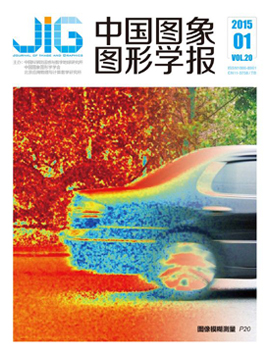|
以分离噪声特征为引导的真实图像降噪
黄颖, 姜茂, 李泽, 王菲, 李艾琳(重庆邮电大学) 摘 要
目的 基于合成噪声训练的去噪模型在实际应用中效果不佳。同时,许多真实图像去噪算法仅对图像进行端到端处理,未充分利用噪声信号的整体信息,不能有效去除噪声对图像结构信息的干扰。针对这些问题,提出了一种以分离噪声特征为引导的真实图像降噪网络。方法 采用特征分离的策略,设计噪声图像到无噪声图像映射和无噪声图像到噪声图像映射的对称网络约束噪声特征分离从而将噪声特征从图像内容特征中分离开来。采用对比学习对噪声特征提取进行进一步的约束,提高模型对噪声特征的学习能力。然后将分离模块提取到的噪声特征作为图像降噪的先验,噪声特征引导网络在特征域进行噪声特征的抑制。最后特别的,双向映射都通过相应的损失函数进行约束,该网络架构具有较强的适应性和稳定性。结果 实验在3个数据集(SIDD,DND sRGB, PolyU)上进行测试。在PolyU数据集上与其他算法相比,峰值信噪比(peak signal-to-noise ratio,PSNR)提高了0.25%,结构相似性(structural similarity index measure,SSIM)提高了0.72%;在SIDD数据集中进行了消融实验以验证分离网络的有效性。结论 本文提出的特征分离-引导降噪模型,综合了特征分离和特征引导的思想,并融合了对比学习的优点。该模型更好地利用了噪声信息,针对性地进行图像降噪,提升了图像降噪的稳定性和泛化性。
关键词
Real image denoising via separating features
Huang Ying, Jiang Mao, Li Ze, Wang Fei, Li Ailin(Chongqing University of Posts and Telecommunications) Abstract
Objective Image noise refers to the distortion phenomenon of visual signals caused by random variations or external interference, which often leads to poor performance in many computational tasks. The core goal of image denoising is to restore clear, accurate, high-quality images from those affected by noise interference, making them more consistent with human visual perception for subsequent image analysis, processing, or visual presentation. Currently, restoring damaged high-quality images has become one of the primary objectives in the field of image processing. Many studies have achieved promising results in dealing with known distributions of noise(such as additive Gaussian white noise). However, real-world noise differs fundamentally from synthetic noise due to its origins from various factors, such as changes in lighting conditions, sensor stability, and environmental interference. This complexity leads to poor generalization ability of models trained on synthetic noise when faced with real noise, resulting in suboptimal denoising effects. Some deep learning methods directly learn residual images through networks and use differences as constraints to achieve the purpose of image denoising. However, real noise exhibits high non-uniformity and complexity, while single-task networks for pixel-space noise separation often overlook the complexity of noise distribution and the correlation between noise and the overall structure of the image. Therefore, this approach easily mistakes non-noise information in the image for noise and removes it, resulting in loss of image clarity and details, thereby disrupting the overall structure of the image. On the other hand, some methods adopt a combination of traditional methods and deep learning, utilizing prior information to separate image data. Compared to traditional direct mapping methods, these methods are more flexible and can more accurately locate and process noise, thereby improving the adaptability to different types of noise to some extent. However, these methods have certain limitations in that they tend to ignore the characteristics of the image itself, which may affect the overall structure of the image during denoising. Additionally, such methods usually require additional computational and network steps, which may be limited in practical applications. To mitigate the impact of noise learning bias on the image itself and better balance prior information and image characteristics, we propose a noise feature separation network. Method In this study, we draw inspiration from the concept of separation and employ a multi-module joint network to achieve feature separation and guidance, named the Feature Separation and Guidance for Real Image Denoising Network. This network comprises a separation module, a guidance module, and a contrastive learning module. Considering that CNN (convolutional neural network, CNN) may overlook the global structural information of images when extracting deep semantic features, the basic architecture network of our network module is implemented using a cross-structure of CNN and Transformer. Firstly, we designed a symmetric network to constrain the noise separation module without relying on any prior information. The symmetric network learns the bidirectional mapping relationship of images by mapping noise images to noise-free images and vice versa. Subsequently, the separated noise features are used as guidance information for the image denoising module, enabling multi-scale guidance for removing noise signal features in the feature space. Lastly, based on the idea of contrastive learning, we further constrain the separation module by leveraging the differences between positive and negative samples to achieve noise feature separation. Since our model learns the bidirectional mapping relationship between noisy and noise-free images, the noise separation module is constrained by structural and contrastive losses, thereby providing more accurate noise signal features for the image denoising module and enhancing the accuracy and generalization performance of the network denoising. Results Experiments were conducted on the SIDD dataset for training and on three datasets(SIDD, DND sRGB, PolyU) for testing. Compared with other real image denoising methods, our method shows more consistent results in peak signal-to-noise ratio (PSNR) and structural similarity index measure (SSIM). Specifically, on the PolyU dataset, PSNR improved by 0.25%, and SSIM improved by 0.72%. Additionally, a series of ablation experiments were conducted, and the effectiveness of each algorithm module was verified through visual demonstrations. Experimental results demonstrate that our proposed algorithm significantly improves the effect of image denoising and enhances the model's generalization performance to a certain extent. Conclusion This study proposes a feature space separation-guided denoising model. Based on the concept of feature separation, this model effectively transforms between feature space and pixel space, enabling flexible learning of noise signal features and providing accurate guidance information for the denoising model. Further adoption of contrastive learning improves the learning of noise signal features. Leveraging the cross-structure of Transformer and CNN enhances the retention of image features during the denoising process, reducing the loss of key information. This network architecture efficiently separates the noise features within the image from its intrinsic features, enabling more accurate localization and processing of noise signals while preserving the original details and structure of the image. By separating and reconstructing noise signals in the feature space, our method minimizes the loss of overall image information during the denoising process, thereby improving denoising effectiveness and maintaining image quality. The proposed method exhibits competitive performance when compared with representative state-of-the-art image denoising methods.
Keywords
|




 中国图象图形学报 │ 京ICP备05080539号-4 │ 本系统由
中国图象图形学报 │ 京ICP备05080539号-4 │ 本系统由